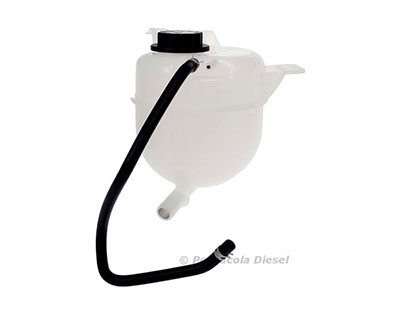

The OEM filter caps are made of a hard plastic that has become prone to cracking and stripping out while doing general filter services. Since our oil filtration system came equipped with billet oil filter and oil filler caps that would allow us to feed and return engine oil at the external 2 Micron AMSOIL filter, it only made sense to replace the factory plastic fuel filter cap with the matching billet piece from Sinister as well.
6.0 powerstroke oil in coolant reservoir install#
During this installation process, we had also opted to install a Sinister billet fuel filter cap. These more frequent filter changes will remove most of the debris from the system and allow you to go to a once-a-year service interval, depending on mileage driven. Sinister says that typically you can expect to change the spin-on filter three times within the first nine months of driving. On the cooling system side of things, the Sinister Coolant Filter kit will start by removing small solid particles from your cooling system to help keep the engine coolers, water pump and radiator clean. With nothing more than basic hand tools we were able to install the complete kit in the garage in less than one hour. The team at Sinister went to great lengths to be sure their kit would fit right and make for a very simple install.

After just going through an expensive parts and labor bill to replace a failed engine oil cooler, we wanted to be sure this wasn’t a situation we’d find ourselves in again anytime soon. We installed the Oil and Coolant Filtration kit on a 2005 F250 with just over 110,000 miles on the clock.

Sinister Diesel’s products can always be spotted thanks to their stylish and distinctive Sinister Blue color, so not only will these parts improve durability, they’ll look good doing it. As one of the fastest-growing online aftermarket diesel parts retailers, the crew at Sinister Diesel spent countless hours engineering and testing their new filtration kits to ensure 6.0L owners could improve their truck’s performance and reliability without throwing hard-earned cash away on stuff that doesn’t work. Owners Brian George and Michael Mitchell started Sinister Diesel after looking to expand their online diesel performance business (MKM Customs) by offering top-of-the-line specialty products and superior customer service skills both before, during and after the point of sale. Looking to combat these fluid temperature problems and keep unwanted debris out of the cooling and engine oil system, Sinister Diesel of Roseville, Calif., has developed a simple to install, external fluid filtering system that can increase oil and coolant filtration, which can help keep the onboard factory coolers running clean and restriction-free for thousands of miles. Remember that EGR Cooler and head gasket failure problem we mentioned earlier? The hot temperatures can also cause the coolant passing through the cooler to overheat, leading to cooling system failures as well. Something, unfortunately, most of us have all been guilty of at some point. Hot oil temperatures cause the oil to break down quicker, which can lead to internal parts failure if it isn’t serviced like it should be. Because of its design, even the smallest amounts of debris can cause a restriction in the system and cause oil temperatures to skyrocket. Another common problem found in the 6.0L Power Stroke is the Engine Oil cooler located in the valley of the engine here, the small cooler has both engine oil and engine coolant running through it to help keep fluid temperatures down while daily driving and towing. Whether it’s Ford’s claims that under the proper care and maintenance, the 6.0L can be as reliable as anything else on the road, or the popularity of the Ford Super Duty truck itself, they are still quite common on the streets of Anytown, USA. Faulty exhaust gas recirculation systems, poor injector design, high pressure oil system failures and weak head gaskets have all become quite common with this platform. Unfortunately, as the miles and time racked up on these vehicles, weak points and lack of execution on the engineering side of things started to come to light and the 6.0L Power Stroke has become a repair shop’s best friend. Their marketing and engineering teams hit things hard and the hype on this new smaller displacement, higher horsepower, cleaner running 6.0L brought Ford right back up near the top. While the 7.3L had been a pretty solid platform, new emissions regulations and better performing engines from both GM and Dodge left Ford scrambling. In 2003 the light duty diesel market, Ford crowd in particular, was excited to test out the new 6.0L Power Stroke that hit showroom floors, ending a near-decade stronghold its predecessor the 7.3L had on the Ford Super Duty market.


 0 kommentar(er)
0 kommentar(er)
